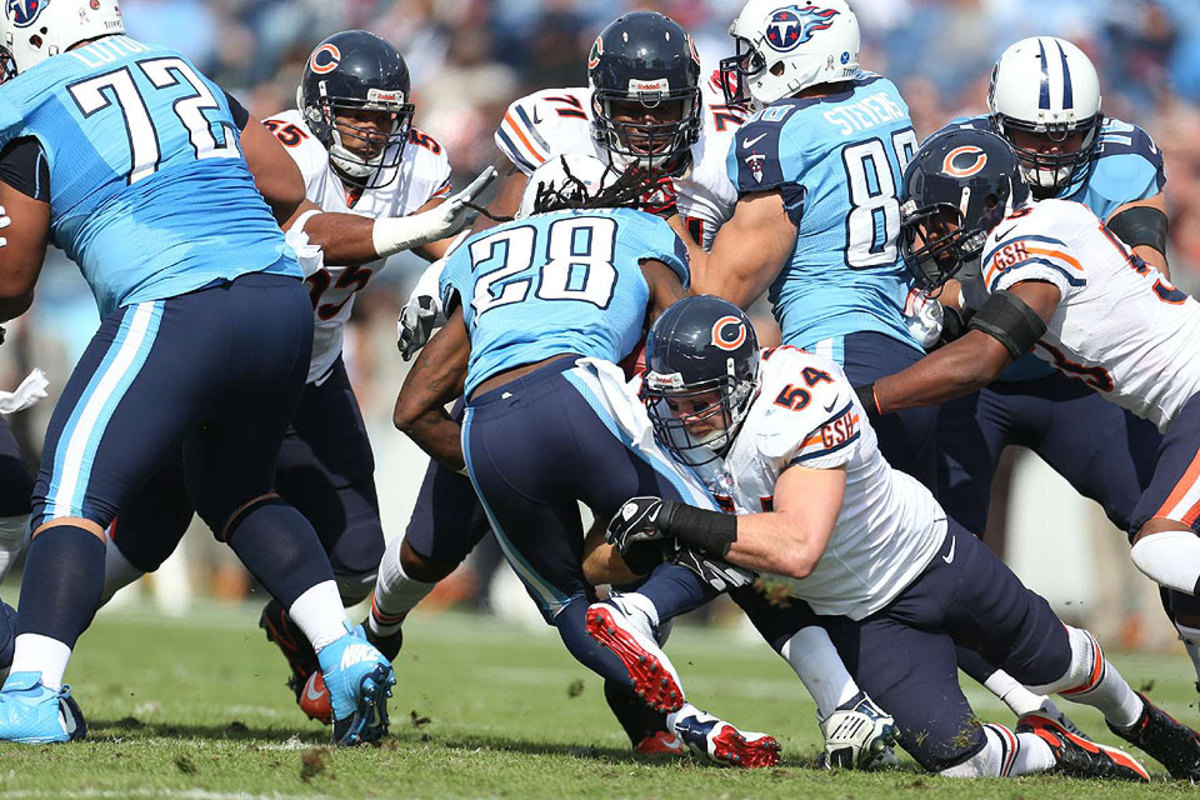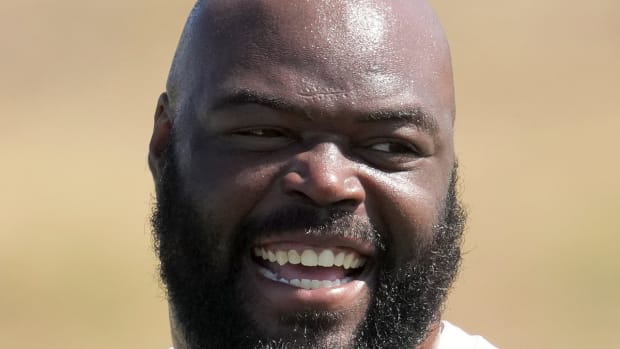Crash Landing for New Jet
After getting released by the Titans and then sitting on the open market for two weeks, Chris Johnson finally found a new team. In New York he’ll likely be taking handoffs from fellow offseason pickup Michael Vick, forming football’s most terrifying backfield if this were 2010.
With the steady Bilal Powell and the explosive Chris Ivory also on the depth chart, Johnson should expect no more than 12-15 touches a week. That might seem like a fall from grace for a 28-year-old who has topped 1,000 yards rushing in all six seasons since being drafted with the 24th overall pick in 2008. But Johnson has been tilting away from superstar status for awhile.
Did you know it was almost five years ago that Johnson had his 2,000-yard campaign? Since adding a “CJ2K” tattoo, Johnson has averaged 73.9 yards per game (1,183 per season). Those aren’t numbers of a pedestrian player, but they aren’t numbers of an electrifying feature back, either. Nine other running backs have averaged more yards a game since ’09 (minimum 40 starts).
So why the drop in Johnson’s production?
Some have speculated that work ethic is an issue. In 2011, midway through a five-year rookie deal worth $12 million, Johnson made good on a two-year-old threat of holding out in demand of a raise. After missing all of training camp and the first three preseason games, he got the Titans to capitulate with a four-year, $53 million contract, with an astounding $30 million guaranteed. Then Johnson went out and had his worst season, rushing for a meager 1,047 yards. He bounced back a bit in 2012 before resubmitting paltry numbers in 2013.
Who knows if Johnson rested on his laurels after becoming filthy rich. Game film does not show drive, only performance. But that doesn’t mean there won’t be speculation. Longtime beat writer Jim Wyatt of The Tennessean wrote that while Johnson is by all accounts a “good guy,” his “laid-back approach” rubbed some in the Titans organization the wrong way. Johnson also hasn’t earned himself much sympathy with his public gripes. (Recall him slapping the faces of his offensive linemen by tweeting “Thank God” right after guard Chance Warmack was drafted.) He seems to have a gift for pointing fingers.
Maybe there are other reasons Johnson has tailed off. He officially touched the ball 408 times in 2009 and another 360 times in 2010. That’s a lot of mileage for a slender 195-pounder.
Johnson has never rushed for less than 1,047 yards in a season.(Wesley Hitt/Getty Images)
Or, what if Johnson was never actually as good as his 2009 numbers suggest? The rest of his career numbers would verify this. In 2009, Johnson had touchdown runs of 91, 89, 85, 57 and 52 yards. That’s great, those big plays count. But they also tend to be aberrational stat-inflators. This isn’t to say Johnson didn’t earn his 2,000 yards; take out his four longest runs and he would have still won the rushing title. But from a broader vantage point, running backs rarely hit monstrous home runs with year-to-year consistency.
Johnson has posted just eight 40-yard runs since leading the NFL with seven in 2009. Last season he had zero such runs. His breakaway jets didn’t fire and he showed little ability to make defenders miss. That’s a major problem in today’s NFL.
Johnson still has good speed—and it can maybe once again be great speed now that his legs will get more rest. But he no longer has world-class speed, and the difference between “world class” and “great” is gargantuan for a player who lacks other attributes to fall back. Most running backs in their late-20s see their wheels lose tread. The great ones come to rely more on their vision, power and sense for setting up angles and blocks.
Johnson has never thrived in these areas. Take his speed rating down from, say, a “98” to an “85” and you have a rudimentary back who gains only the yards that are blocked—and sometimes not even that given his propensity to abandon play designs to chase home runs.
A back like this is easy to find, which explains why Johnson went unsigned for so long. If you’re a GM, why bring in a 28-year-old Johnson when, for virtually the same price (and probably less), you can draft a 22-year-old who won’t wear down over the next few years and might even blossom into a star? The young guy is also easier to mold, which is important with a complementary player.
The Jets, of course, have a different view. Signing Johnson is a low-risk move for GM John Idzik and, more importantly, head coach Rex Ryan. Like other one-trick ponies, Johnson could excel in a limited role depending on how those around him perform. And if the experiment goes up in flames, nothing else on the team will conflagrate because we’re then talking about a low-level backup. Johnson might not be the Jets’ next version of LaDainian Tomlinson. But at least he won’t be Mike Goodson.







































